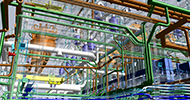Having reliable and long-lasting conveyor systems is essential for the productivity of mining operations. However, alignment of conveyors is often overlooked and the reliability of the conveyor system is undermined.Common conveyor issues caused by misalignment include belt failure and premature pulley wrapping and/or pulley-bearing failure. Any of these problems will cause the extremely costly halt of production and emergency repairs. Regular preventive alignment inspections help to reduce these costs, and improve operating efficiency.
Due to the nature of mining operations, many conveyors are erected as temporary installations. As a result, most pulley-bearing mounting plates are simply a piece of steel plate welded onto the structure of the conveyor frame. The flatness of these mounting plates is often marginal due to welding and in most cases, the two bearing mounting plates are not coplanar.
The lack of flatness can create a great deal of stress in the bearing housing once the bearing housing is bolted down onto the mounting plate. Deformity occurs as the bearing housing begins to take the form of the plates. This angle between the mounting plates increases the difficulty to align the pulley and the gap of the bearing sealing. To correct this alignment problem, an OASIS metrology engineer begins by using a Leica Absolute Tracker AT960 laser tracker to survey the mounting plate surface in order to shim the plates.
Read more on how OASIS Alignment Services uses the Leica Absolute Tracker AT960 laser tracker to reduce downtime.













